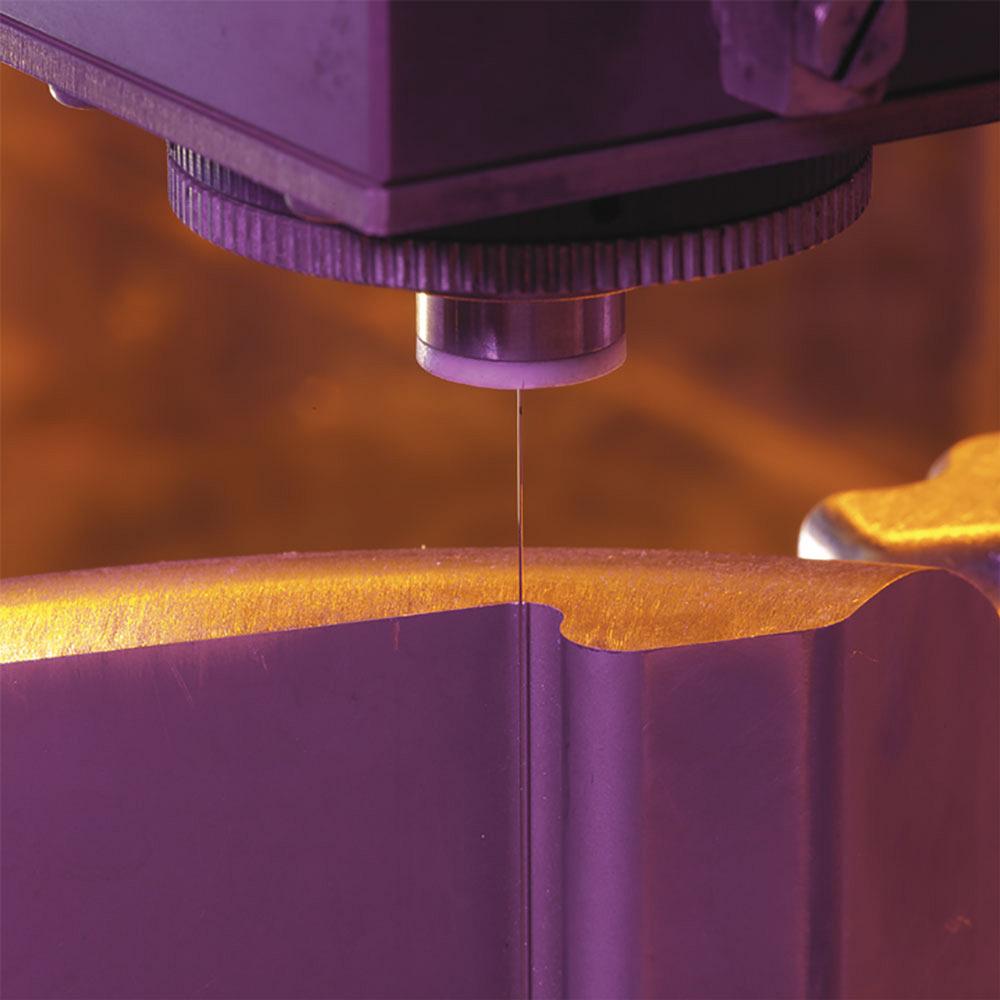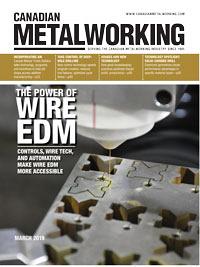Associate Editor
- FMA
- The Fabricator
- FABTECH
- Canadian Metalworking
The expanding applications for wire EDM
Advanced controls, smart technology, and expanding applications make Wire EDM more accessible
- By Lindsay Luminoso
- Updated May 18, 2023
- March 25, 2019
- Article
- Metalworking
Wire electrical discharge machining (EDM) has been around for decades, yet this technology has never eclipsed other machining processes on the shop floor. That’s because EDM offers an interesting value proposition—it’s capable of cutting any part that is conductive, regardless of its hardness, where conventional metal removal is challenging or impossible, but the process itself is gradual. Experts agree that shops have always been somewhat apprehensive when it comes to adopting this technology.
"EDM has had a stigma of being a black art," said Brian Pfluger, EDM product line manager, Makino, Mason, Ohio. "Shops with little to no experience were unwilling to explore this technology, but there has certainly been a shift as of late."
"Although wire EDM still only holds a small market share, it definitely has its place," said Steve Raucci, EDM product manager, Methods Machine Tools, Inc. "Aerospace and medical are some of the industry sectors that implement EDM, but the firearm industry is another big player in the EDM market. EDM is a slow process, but there are still parts that have to be produced with a wire. Sometimes there’s no other way to do it."
Manufacturers have focused on how small and fine the EDM process could go. However, in the past few years, the process itself has hit somewhat of a plateau. There have been some areas of improvement. For example, the experts argued that even as early as 10 years ago, safety-critical aerospace components never would have been produced on an EDM. However, power supplies and wire have been adapted to ensure that parts can be produced with no recast and with varying material thickness with ease.
"When you need to produce sharp corners or deep ribs, features that a conventional milling tool can’t get down into, wire EDM is a great option," said Sean Smith, sales manager—Canada, GF Machining Solutions, Mississauga, Ont. "These machines are versatile, and we especially see a need in areas where materials are becoming harder, with high nickel content, which puts increased pressure on tooling and spindles. EDM is perfect for these applications."
EDM has captured a unique market share, and although certain features have plateaued, one development has come in work envelope size.
"We are seeing an increase in part size in the industries EDM tends to serve," said Evan Syverson, additive and HSM business manager, Sodick Inc., Schaumburg, Ill. "That has really started to influence some of the specs and design of these machines. The machine footprint is growing in response to the type of work that we’re seeing, particularly in the Z axis."
EDMS FOR ADDITIVE MANUFACTURING
Beyond the traditional sectors, metal additive manufacturing (AM) is a new market opportunity for EDM. Most manufacturers offer a range of EDM machines, from basic models to top-of-the line machines with all the bells and whistles. However, machines designed for metal 3D printed parts have a very specific function.
"Metal 3D parts are built on top of a base plate, which needs to be removed," explained Syverson. "When a part is printed, it usually has a relatively wide XY axis travel, but in order to remove it from that plate, it needs to be reoriented, so it can be upright and separated with a wire EDM."
These machines need a relatively high Z axis to be able to accommodate the parts and do not need to be able to perform multiple part passes or produce super-high precision. EDM for 3D-printed parts requires general speed and the basic ability to remove a part from the base plate. More manufacturers are focused on providing machines designed for this market segment as AM becomes more common.
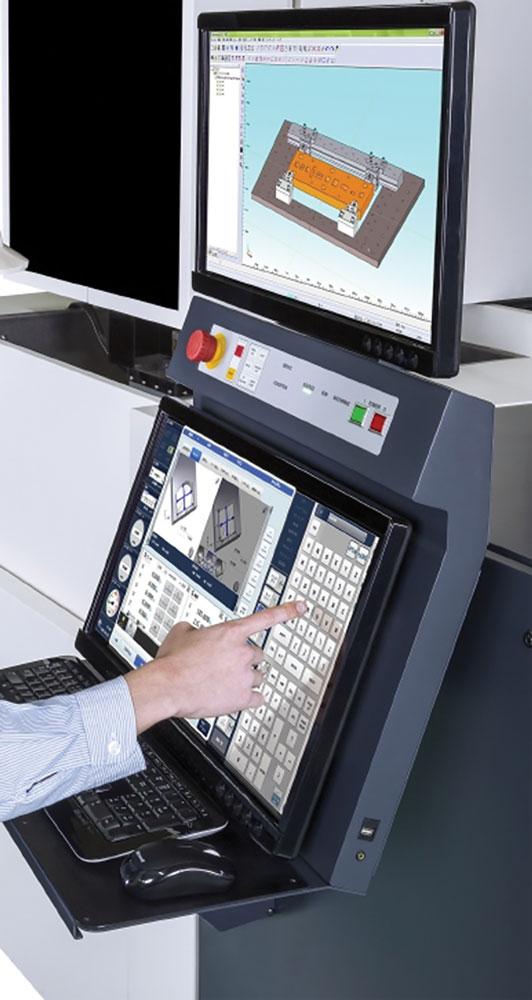
The latest intuitive controls allow even the most inexperienced operator to make very precise, expert-level adjustments to the machine without needing to know the underlying technology. Photo courtesy of Makino.
Controlling Wire EDM
Manufacturers of this technology have adapted the system to make it easy to use, dispelling the notion that EDM is some sort of "black magic" that only experts in the field can operate.
"Upgrading the control systems has helped eliminate the fear of the unknown, where operators don’t want to press the wrong buttons or don’t understand how to interact with the machine," said Pfluger.
The latest intuitive controls allow even the most inexperienced operator to make very precise, expert-level adjustments to the machine without necessarily needing to know the underlying technology. Graphical interfaces, which provide numerous adaptive controls, make is easy for the operator to adjust parameters to fit the job. This is especially important because it often can be a challenge to find qualified operators who have previous EDM experience.
"The controls and the technology have gotten simpler and easy to operate than they were even 10 years ago," said Raucci. "The interface allows the operator to select wire diameter, material thickness, and so forth. The machine will calculate the cutting parameters needed to get the job done." Raucci added that this is a significant improvement in the past few years. When he first started in the business, cutting parameters were found in manuals, and if what an operator was looking for wasn’t included, he would have to play around with the specs to get the right options.
"Now, all you really need to know is the size of the workpiece, the tolerance that you’re looking for, the surface quality that you’re trying to achieve, along with the wire that you choose," said Smith. "It’s now easy as filling in the blanks on the control. The machine takes over from there."
The machines also come with features to help with productivity gain. Manufacturers have recognized that adding an economy mode or power-saving options is beneficial for users who operate the machine in lightsout scenarios.
Smith gives the example of running a job over the weekend, where there is no rush to have the part completed as quickly as possible. Features like economy mode will reduce the operating parameters, saving wire and power consumption. So instead of having a part finished Saturday afternoon running at full operating costs, the part can be finished several hours later with the machine running in a power-saving mode.
The Wire in Wire EDM
"One of the big pushes on the market these days is the ability to thread the wire in the gap," said Pfluger. When a wire breaks, which can happen, this capability allows the wire to be rethreaded right at the breaking point rather than having to go all the way back to the start.
"You almost couldn’t have lights-out operations if it didn’t have a break detection system," said Syverson.
Manufacturers are focused on developing advanced wire threaders that increase productivity, offer better reliability, and improve part processing. Having a system that also detects wire breakage and alerts the operator makes it easier to get the machine back up and running efficiently.
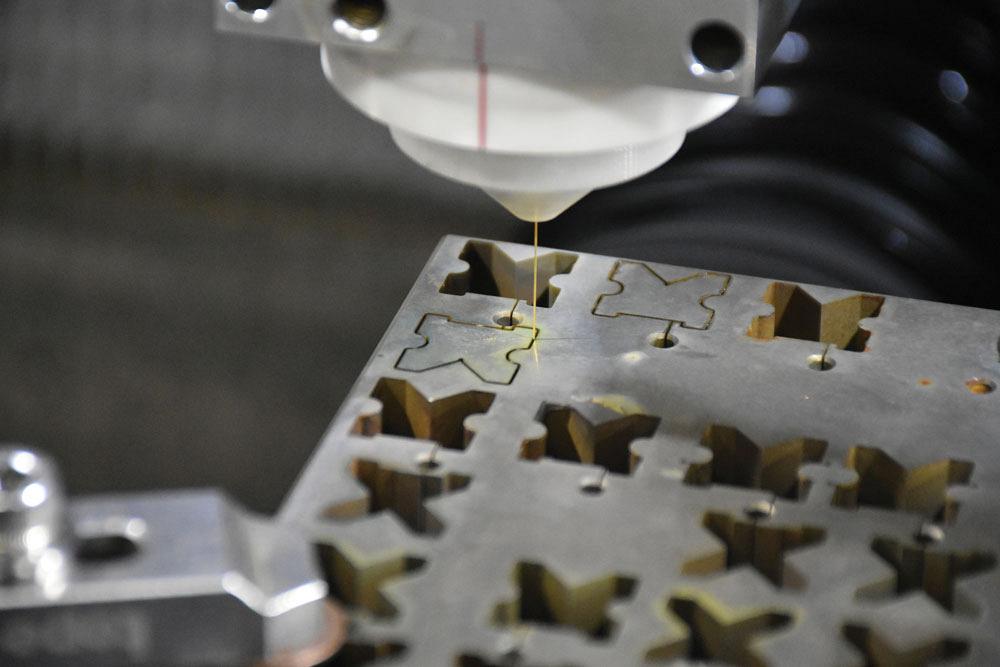
Slug retention prevents slugs from dropping and eliminates the need for clamps. An automatic wire feed system can thread through the kerf, which allows for full utilization of this feature. Photo courtesy of Methods Machine Tools.
Wire threaders and break detection systems are important components, but Pfluger explained that one of the biggest costs of machine operation, besides paying an operator to run the machine, is the wire itself. More manufacturers are focusing on developing more efficient machine settings that consume less wire while maintaining part quality.
This has led to many manufacturers now offering large-diameter wire technology. For example, Pfluger explained that the most common wire has a 0.25-mm diameter, but more and more operators are using a heavier-gauge wire, like a 0.3-mm-diameter wire, because it offers speed benefits. Generally, the faster the machine operates, the more an operator has to sacrifice the finish and accuracy performance of traditional wire sizes using larger-diameter wire. However, manufacturers are developing optimized settings on the machine that deliver the same surface finish and accuracy using the higher gauge as traditional wire delivers. This allows for upwards of 20 per cent cycle time savings, especially in rough cuts. It also lowers wire consumption, which leads to significant cost savings.
LIGHTS-OUT OPERATIONS
Wire EDM has some built-in limitations and machine variables that make it challenging to automate, which is why robotic automation has never been a common trend with this technology. But the experts agree that more customers are inquiring about ways to automate the process.
"We are seeing more and more EDM cells with specialized automation," said Raucci. "Ten years ago there was nothing like this. The cells tend to have multiple EDM machines with rail system automation. This trend is becoming more popular because of increased labour costs and lack of skilled operators."
Raucci noted that there is still a big divide in what customers are looking for. He said that some like the standard machine with a single operator, while others jump in with full lights-out capabilities. This could include a rotary table with additional automation and a probe. Incorporating probing ensures part quality, which can be extremely beneficial for anyone looking to run lights-out operations.
"Adding automation is definitely a way for customers to be more competitive in the marketplace," added Smith. "They can go from a very basic pallet changer system all the way up to multiaxis robots that help load the machines."
The experts agreed that automation and lights-out operations are making it easier for shops to get into the technology. However, Smith cautioned that shops looking to incorporate a robotic cell also need to ensure they always have enough wire supply to fully take advantage of the technology. For the most part, the machines today can hold about 55 lbs. of wire, which gives approximately 80 hours of unattended cut time and energy.
"The technology itself has come such a long way over the years," said Syverson. "If an operator can use the controls and onboard programming software, the machine essentially runs itself. And now, with automation, there are more ways than ever for shops to take advantage of the unique capabilities of EDM."
Associate Editor Lindsay Luminoso can be reached at lluminoso@canadianmetalworking.com.
GF Machining Solutions, www.gfms.com
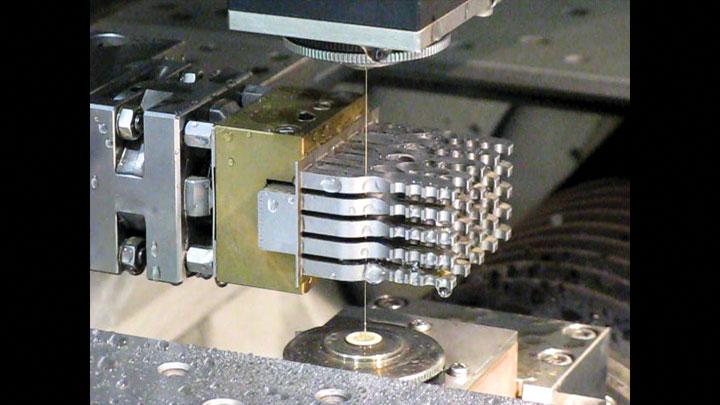
"One of the big pushes on the market these days is the ability to thread the wire in the gap," said Brian Pfluger. Photo courtesy of Makino.
Makino, www.makino.com
Methods Machine Tools, www.methodsmachine.com
Sodick, www.sodick.com
About the Author

Lindsay Luminoso
1154 Warden Avenue
Toronto, M1R 0A1 Canada
Lindsay Luminoso, associate editor, contributes to both Canadian Metalworking and Canadian Fabricating & Welding. She worked as an associate editor/web editor, at Canadian Metalworking from 2014-2016 and was most recently an associate editor at Design Engineering.
Luminoso has a bachelor of arts from Carleton University, a bachelor of education from Ottawa University, and a graduate certificate in book, magazine, and digital publishing from Centennial College.
subscribe now


Keep up to date with the latest news, events, and technology for all things metal from our pair of monthly magazines written specifically for Canadian manufacturers!
Start Your Free Subscription- Trending Articles
Identifying the hallmarks of a modern CNC

Tooling for spot facing and counterboring is completely customizable

CTMA launches another round of Career-Ready program

Collet chuck provides accuracy in small diameter cutting

Sandvik Coromant hosts workforce development event empowering young women in manufacturing

- Industry Events
MME Winnipeg
- April 30, 2024
- Winnipeg, ON Canada
CTMA Economic Uncertainty: Helping You Navigate Windsor Seminar
- April 30, 2024
- Windsor, ON Canada
CTMA Economic Uncertainty: Helping You Navigate Kitchener Seminar
- May 2, 2024
- Kitchener, ON Canada
Automate 2024
- May 6 - 9, 2024
- Chicago, IL
ANCA Open House
- May 7 - 8, 2024
- Wixom, MI













